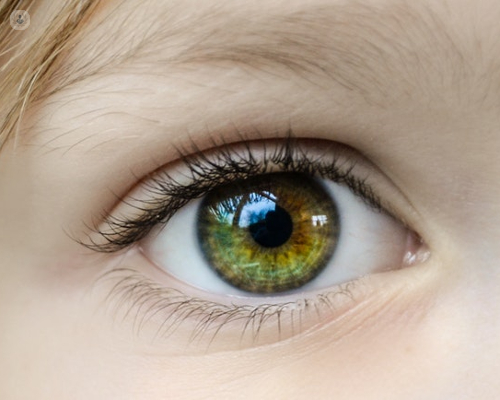How are eye melanomas treated?
Autore:Eye melanomas are cancers which occur when cells multiply in an unregulated fashion. This is due to mutations within the genes which make them unable to control the cells and their development. In this article, we invite internationally renowned consultant ophthalmologist Professor Bertil Damato to give expert insight on treatment options for eye melanoma as well as explaining how exciting innovations in the field are offering improved outcomes for patients.

How are eye melanomas diagnosed?
The large majority of melanomas can be diagnosed by an expert looking at the tumour with specialist equipment, such as a slit lamp or an ophthalmoscope to see the eye or colour photographs of the tumour.
Distinguishing benign (non-cancerous) moles from melanomas is key in avoiding unnecessary investigations and providing quick treatment to those who need it. At the University of Oxford, I devised a mnemonic for diagnosis and scoring system which has now been validated and adopted by Moorfields Eye Hospital and the Royal College of Ophthalmologists as a reliable way for optometrists and ophthalmologists to more accurately make diagnoses and referrals.
What are the known causes of melanoma?
With most patients, there’s no real obvious cause for the melanoma, except that these tumours are more common in individuals with fair skin and light-coloured eyes and less common in patients with dark skin and dark eyes.
There are also some other causes. For instance, there’s a particular kind of mole at the back of the eye called a melanocytoma, which has a tendency to change to melanoma in perhaps one in three to four hundred cases. Additionally, there’s also a malformation where you have too many melanocytes in the eye from birth and that increases the risk of melanoma.
Finally, there’s a particular syndrome known as the BAP1 tumour predisposition syndrome which can be inherited and tends to cause tumours in the kidney, mesothelioma in the lung and skin melanomas as well as intraocular uveal melanomas (eye tumours).
What treatment options are available for patients with eye melanoma?
The treatment options are radiotherapy, laser therapy, surgical excision (removal) of the tumour or removal of the eye.
My first choice of treatment is plaque radiotherapy. In this treatment, we implant a plaque which is the size of a five or ten pence coin, behind the eye next to the tumour. The plaque’s radiation penetrates the tumour (to around 5 or 6 millimetres) and it remains in place for between five and seven days until the tumour has been sterilised. Then we remove the plaque by means of a second operation.
It’s really important to place the plaque right next to the tumour and so I have developed techniques and instruments for positioning the plaque very precisely so we increase the chances of killing the tumour while reducing the risks of damage to surrounding tissues such as the optic nerve.
If the tumour isn’t suitable for plaque radiotherapy, either because it is too big or because of it’s awkward location near the nerve, then we may want to treat it with proton beam radiotherapy. To do this, we first stitch four tiny markers onto the wall behind the eye and near to the tumour which will show up on an X-ray. After two weeks, X-rays are taken to help create a computer model of the eye so that a plan for treatment can be made. According to this model, the patient undergoes a four day course of radiotherapy (one hour a day for four days) which kills the tumour.
With good patient selection, the chances of sterilising the tumour with plaque or proton beam radiotherapy are more than ninety-five out of a hundred- a very good chance of success.
Large tumours in the eye leak fluid out under the retina and when given radiotherapy treatment are also starved of oxygen, causing damage to the veins and arteries and thus killing the tumour. This process however, can cause the body to produce hormones to stimulate the growth of new arteries and veins. Consequently, the excess fluid may cause the patient to develop retinal detachment, loss of vision and the new veins can clog up the gutter of the eyes leading to high pressure in the eye and perhaps painful neovascular glaucoma. In these cases, the eye may need to be removed.
I refer to these side-effects as ‘toxic tumour syndrome’, which can be treated by giving injections into the eye which suppress the formation of these hormones and the leakage of fluid from the damaged veins.
We don’t usually use laser treatment these days because it's not as reliable as radiotherapy but there is a technique known as photo dynamic therapy where a drug, which is activated by a cold laser, is injected into the area. When the laser is shone, the drug causes damage to the veins and arteries in the tumour and so kills it.
There is also the possibility of removing the tumour surgically either by making a trap door to remove it or by hoovering it away through a tiny microscopic vacuum cleaner. These types of surgeries are big and complex and so are not widely performed.
If the tumour is not suitable for any of these treatments then it is necessary to remove the eye. Despite this appearing an unfavourable option, patients are pleasantly surprised how normal life is after the procedure. My colleagues and I have done a quality of life study in around one and half thousand patients who very kindly submitted questionnaires over about twenty years. We found that the patients’ quality of life after eye removal was very similar to those who underwent radiotherapy. This, of course, relies on the other eye having good vision. This is very important for us and for our patients to understand when deciding whether or not to try to save the eye during treatment for melanomas.
Are eye melanomas curable?
In intra-ocular (in the middle part of the eye) and conjunctival (on the ocular surface) melanomas, the smaller the tumour, the greater the chances of curing the tumour and the patient and of preventing loss of vision and loss of the eye.
With regards to survival, it all depends on whether or not the tumour has developed certain mutations in chromosomes 3 and 8. If those mutations have occurred, then the risks of tumours in the liver and other parts of the body are very high. Whereas, if the mutations are absent, the risk of metastatic disease is very small.
In some patients with these mutations, they develop so early that by the time the patient is first seen by an optometrist or an ophthalmologist, they have already occurred and tumours may have already spread to the liver or other areas. The earlier we treat these tumours, the greater the chance of killing or removing them before these mutations have occurred and as such preventing their spread.
If left untreated, how serious can eye melanomas become?
Tumours in the eye, if left untreated, will grow bigger and will first affect the vision. As the tumour grows bigger, it will cause inflammation, high pressure and pain so the eye will eventually need to be removed.
If tumours are left to grow, they can invade the tissues behind the eye and push the eye forward. Also, the longer the delay in treatment, the greater the chance of these tumours developing life threatening mutations and tumours spreading to the liver and other parts of the body.
Untreated conjunctival tumours can also cause a large brown or black mass to develop on the surface of the eye.
What are the stages of melanoma?
Tumours in the body are assessed according to a staging system called TNM which classifies the tumour according to its size, location and extent. There are TNM systems for both intra-ocular and conjunctival melanomas which I was involved in developing.
The most vitally important thing to assess is the genetic status of the tumour. If you get mutations in chromosome 3 and 8, damage to the BAP1 gene or certain kinds of gene expression profiles then the chances of the tumour spreading are very high. Combining the anatomic features of the tumour using this system, along with microscopic features determined in a pathology lab and the genetic mutations gives you an accurate prognosis for each patient.
My colleagues and I have developed a prognostic tool that combines all of these predictors and statistically calculates the chances of survival for each patient. It is a very accurate predictor and is now widely used. With conjunctivital tumours, the location and the size are the main features of predicting survival rates.
It's really important to know the risk of tumours developing in the other parts of the body as if a patient has a high risk, you can monitor them, such as through liver imaging scans every few months, to pick up and treat tumours in other parts of the body quickly.
This has become more important recently because there are new treatments providing exciting results meaning that by detecting and treating tumours in the liver or other parts of the body through screening and specifically targeting high risk patients, the likelihood of survival is increasing. These new developments in the past twenty years have completely changed the landscape for treating eye melanomas and other secondary cancers.
If you are concerned about eye melanomas, you can book a consultation with Professor Damato by visiting his Top Doctors profile.



